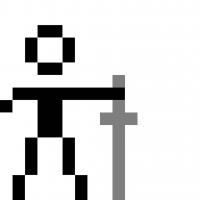Lol yeah. Originally outerra was being created for the purposes of some kind of grand strategy / civilization type world building game... but they seem to have spent their entire time just building the awesome planet renderer.
Now, how to make anything meaningful with the empty world created....
Procedurally generated planet Earth 1:1
. 22 Racing Series .
Apart from some understandable skepticism, fairly encouraging. Confirms what I have in mind.
As I mentioned, the planet would be wiped clean. Just sand, snow and oceans, seas, rivers with plain bottoms. No grass, no trees... nothing. It all makes sense, trust me. ![]()
There would be 'something' on the planet (for gameplay/story reasons), but as far as asset amount, it shouldn't take too much.
If you want to get the basic idea - put together Minecraft, Sims style game, city building game, combat something like Planetside 2, farming game, etc, + modding/content creation as part of actual game.
And that content creation part is probably the biggest part of all of it. For two reason I would like to go that route. 1. devs give the guidelines for world, but world itself is built by players. And we all know how much peoples like to build stuff. At the same time there would be non-world-building gameplay. 2. of course it would be crazy to try to make whole detailed world from dev side. Not that it is impossible. But certainly way too expensive for indie.
So it is something like creating canvas and giving tools to players to fill it. Has only enough prebuilt stuff to be functional, bug free and have good initial gameplay. For instance - have 3 types of guns designed by devs. Rest of the guns are designed by players, submitted and reviewed by other players, that then it ends up in game.
Game with something for everyone.
There are far more procedural generation related stuff that I knew. And that Outerra looks really interesting. As I'm checking it out now it really looks like good fit.
Would be nice if I could use already existing engine.
So thanks for info so far, really helpful!
So it is something like creating canvas and giving tools to players to fill it. Has only enough prebuilt stuff to be functional, bug free and have good initial gameplay. For instance - have 3 types of guns designed by devs. Rest of the guns are designed by players, submitted and reviewed by other players, that then it ends up in game.Game with something for everyone.
That is a sound idea, until your players start to build their creations... I see many a depiction of male reproduction organs as buildings, weapons, or whatever else the players are allowed to build.
As long as you do not police it yourself, it will happen. If that is a problem to you or the game, IDK.
Just keep the example of Second Life in mind... took a couple of years, and the game (???) turned into nothing more than a virtual red light district. Of all the possible things people could do in the world, only the kinkiest where actually acted out after everyone else either lost interest and left the game, or got grossed out by other players and left the game.
Being prepared for that and finding a happy balance between player freedom and limiting the amount of trolling and griefing that is possible thanks to the creation tools certainly will not hurt... seems even Minecraft has the problem, and no failsafe solution: http://minecraft.gamepedia.com/Tutorials/Griefing
Yes, using an existing engine will certainly help you a lot! As the saying goes, "build games, not engines!".... unless you want to become an engine programmer, that is.
Anyway, good luck
That might be true... but when you move from just procedural generation to mixing real geodata with procedural generation, wouldn't that make the project far more complex?
There's a fair bit of work in compression and paging of the geodata, but that's largely a solved problem.
Google Earth looks real enough, and their height data is quite sparse: accuracy of +/- 30 metres, with grid points every 90 metres. Any added procedural detail is just a bonus to recapture details usually filled by high-resolution diffuse maps from satellite imagery.
The general trick is to just use the derivatives of the geodata to control and modulate the procedural detail. i.e. in steep areas you can add more noise than in flat areas, use ridged multifractals at high and low elevations, fBm between those extremes... all sorts of tricks. They take time to work out, but individually none are that complex.
In practice you'd probably want to go a bit deeper, and generate a biome mapping by processing satellite imagery (or mining other data sources). Forests, deserts, mountains, tundra, prairie, glaciers... all pretty easy to determine from colour satellite images, all can have separate noise profiles.
Tristam MacDonald. Ex-BigTech Software Engineer. Future farmer. [https://trist.am]
I see many a depiction of male reproduction organs as buildings, weapons, or whatever else the players are allowed to build.
Yes, that could be a problem. What I have in mind is making it expensive when it comes to resources.
And mod style creations like weapons, vehicles etc - it is unlikely that community would vote for trolling creation to be included in game.
My idea is to make resources expensive enough so players need to be in guild type thing to build big, or even some kind of alliance of guilds if project is city sized. At the same time keeping resources no too expensive, so players can reasonably fast gather resources for their own weapons, armor, vehicles and housing.
There have been a few projects, mainly more academic research projects rather than direct game related stuff, that produced worlds/game spaces comparable to earth. Minecraft is technically larger than earth if I remember correctly, being able to generate several times the entire surface area of earth. However you would have to be exceptionally bored to actually manually walk to the edge of a world, and one part is much the same as any other.
From a game stand point you really have to ask yourself, "What are you going to DO with all that space". What is the point? What will the player do in it, and how will they travel around it? What will be the point of traveling?
Making a big procedurally generated space to play in is easy. The hard part is making it interesting and making the player want to play in it.
What do you plan to do in the game? Write out a story of a player actually playing your game: I load up your game, I am plopped down on your procedurally generated planet that is 1:1 scale of earth, and I do... What? What happens? Where do I go? What do I do?
+1
I do want to reiterate this point. While a planet-size terrain generation is an impressive tech demo, turning it into a *fun* game is a different kind of development work. Please don't see this tech demo as "omg, that could make an awesome game". A tech demo is a tech demo, a game is a game. What would players do with all that space? Have a quest that starts in the American continent, and player has to walk all the way to Asia and back to complete it? How would players the travel, what would they do?
Smaller map sizes in recent games is not because larger maps are technically impossible. It's that you have to fill in all that blank space with interesting tidbits. Even Minecraft, which is possibly the closest to your idea, still limits its size.
Simply having a larger world wouldn't make it a better game. It's about finding the balance between the numbers of players vs the size of the world.
Simply having a larger world wouldn't make it a better game.
That is 100% true. I have solutions for that in mind and by no means the alternate Earth wouldn't be empty desert with noting else but sand and water in it. If this thing is technically possible (and it looks like it is), then I will of course get deeper in to story and gameplay ideas.
Until then I have to be careful what info I give. I just don't want to spoil some stuff, in case I succeed. What happens in internet, stays in internet.
Interestingly Outerra has just had a new release: Version 16.6601 (25 Mar 2016) taking things to an even higher level with OSM river support, new 30M SRTM, rain and snow variable whether effects, enhanced road tools, updated textures, WIP oculus 0.8 support.......
A lot of stuff! :cool:
As the person above me mentioned, The Outerra engine (http://www.outerra.com/) will be relevant, as their tech demo does exactly what you describe (using real geodata with procedurally generated details to make a 1:1 scale Earth). The requirements for Outerra, compared to modern AAA PC games, are surprisingly modest (2GB RAM, mid-tier graphics card, Windows VIsta and up, 15GB of hard drive space for height data). It's a small dev team behind it, so I imagine the licensing costs aren't outrageous.
Of course, the hard part of making a game is making the game. Having the whole earth to explore is nice and all, but if you don't have a reason for it, it's just empty space.








